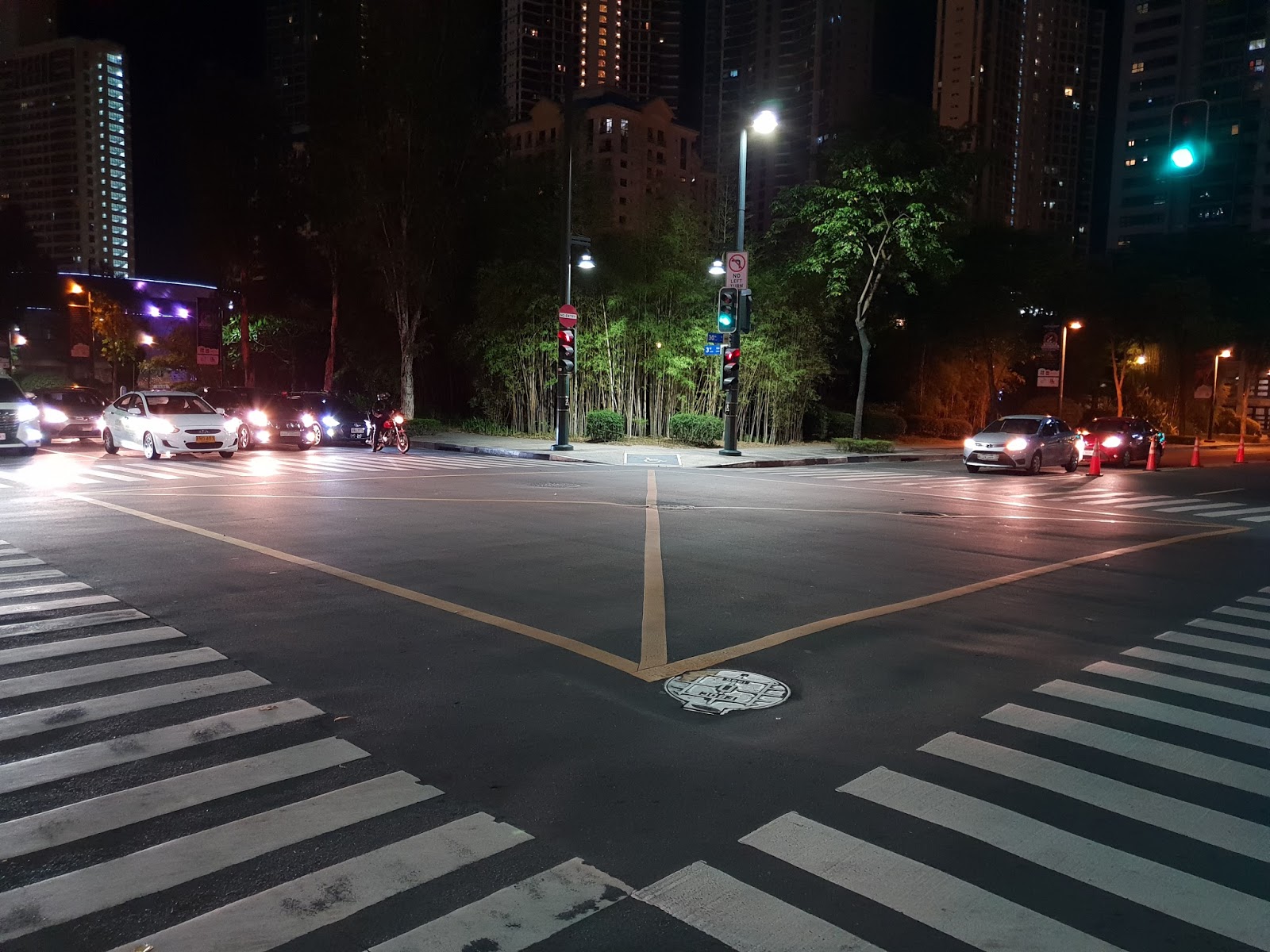Huawei P20 Pro vs Samsung Galaxy S9+ Low Light Camera Shots Comparison
I was having coffee at Tim Hortons in Bonifacio Global City late last night - Wednesday, May 8, 2018 - when I remembered that I have both my Huawei P20 Pro and Samsung Galaxy S9+ review units in my bag.
I took them out and it dawned on me that the setting presents the perfect opportunity to compare the imaging performance of these two powerful cameraphones in low light situations. (After all, the ability to replicate and deliver brilliant colors and crisp details when there's little ambient light is often what separates a great camera from all the rest.)
So why these two? Based on my experience using both of these models as imaging companions on a daily basis, I would say that they are two of the best cameraphones currently; They're certainly right up there in my top five or six all-times list of the best smartphones for imaging.

Samsung Galaxy S9+ Camera Overview
Like the popular Samsung Galaxy Note8 phablet, the 2018 flagship model Samsung Galaxy S9+ has a Dual Camera Set-up that enables 2X Lossless Telephoto Zoom and Live Focus Effect, which blurs out the background of the subject in a beautiful way to deliver more appealing portrait or product shots.
Aside from the that, similar to its smaller sibling - the Samsung Galaxy S9, the S9+'s 12 MegaPixel main camera with very wide f/1.5 Aperture, Optical Image Stabilization, and Dual Pixel PDAF now delivers better shots in low light conditions and provides overall enhanced color replication and sharpness.
Huawei P20 Pro Camera Overview
Crafted in partnership with Leica, Huawei P20 Pro's three rear optics make it one of the best Android cameraphones ever released.
The main 40 MegaPixel RGB camera that has a big 1/1.7" sensor (just behind that of Nokia 808 PureView and Nokia 1020 PureView in terms of size) works in tandem with the secondary 20 MegaPixel monochrome or black-and-while optic to capture photos with stunning sharpness and saturation even in settings where there's little ambient light.
The third 8 MegaPixel shooter has an 80mm focal length and this gives practically works as the telephoto lens of the smartphone. This optic works with the other two cameras, enabling Huawei P20 Pro's 5X lossless zoom capability.
On top of these, this powerful handset has Master AI technology that's able to identify 19 different subjects or conditions - including cats, dogs, food, portrait, and beach, among others - in real-time to instantly implement the right adjustments and lighting effects, which can greatly improve the overall image quality.
Just Low Light Comparison For Now
Obviously, Samsung Galaxy S9+ and Huawei P20 Pro have a plethora of incredible imaging capabilities and features that can be compared.
In this post, however, I decided to check how well their cameras perform in low light conditions, side by side each other, using automatic settings.
As such, I chose similar subjects for both devices and tried to shoot from the same angle or position. I even placed the resulting images on top of each other for better comparison. Note, though, that in my desire to present the photos straight-out-of-camera, I didn't crop them for better fit in the juxtaposed set presentation. I hope you understand.


TechPinas Commentary: The photo taken using SGS9+ is not only warmer but also brighter. Notice that the contents of the cabinet under the wall are more visible in that photo. That said, the P20 Pro image has higher contrast and the difference between the brightness of the wall and that of its reflection on the glass is more pronounced.


TechPinas Commentary: Here, the Huawei P20 Pro shot looks a lot warmer and brighter from corner to corner. In contrast, the photo taken using Galaxy S9+ is way "cooler" and looks darker -- especially in the lower part.


TechPinas Commentary: Samsung Galaxy S9+ delivered an ever slightly brighter image but Huawei P20 Pro was superior in capturing details despite so little ambient light. I mean, the interior of the building is more visible and clearer in the P20 Pro shot.


TechPinas Commentary: I'd say the two cameraphones are practically even in this set -- with the SGS9+ shot being slightly warmer, which the reds and yellows to pop out more.


TechPinas Commentary: Frankly, the image taken using Huawei P20 Pro is superior to that of Samsung Galaxy S9+ in this set. The Leica Triple Camera module clearly minimized the haze around light sources and reflections -- including the road itself. Also P20 Pro allowed the lights and white walls of the building in the background to be more visible in the resulting image.
Alright! I've given you my thoughts about each set presented above. Now, let me hear yours. "Which of these two cameraphones is superior in low light imaging? Which one are you more likely to purchase this year?" Leave a comment below or message me on Facebook, Twitter, or Instagram. I'll be waiting. Cheers!
I took them out and it dawned on me that the setting presents the perfect opportunity to compare the imaging performance of these two powerful cameraphones in low light situations. (After all, the ability to replicate and deliver brilliant colors and crisp details when there's little ambient light is often what separates a great camera from all the rest.)
So why these two? Based on my experience using both of these models as imaging companions on a daily basis, I would say that they are two of the best cameraphones currently; They're certainly right up there in my top five or six all-times list of the best smartphones for imaging.

Samsung Galaxy S9+ Camera Overview
Like the popular Samsung Galaxy Note8 phablet, the 2018 flagship model Samsung Galaxy S9+ has a Dual Camera Set-up that enables 2X Lossless Telephoto Zoom and Live Focus Effect, which blurs out the background of the subject in a beautiful way to deliver more appealing portrait or product shots.
Aside from the that, similar to its smaller sibling - the Samsung Galaxy S9, the S9+'s 12 MegaPixel main camera with very wide f/1.5 Aperture, Optical Image Stabilization, and Dual Pixel PDAF now delivers better shots in low light conditions and provides overall enhanced color replication and sharpness.
Huawei P20 Pro Camera Overview
Crafted in partnership with Leica, Huawei P20 Pro's three rear optics make it one of the best Android cameraphones ever released.
The main 40 MegaPixel RGB camera that has a big 1/1.7" sensor (just behind that of Nokia 808 PureView and Nokia 1020 PureView in terms of size) works in tandem with the secondary 20 MegaPixel monochrome or black-and-while optic to capture photos with stunning sharpness and saturation even in settings where there's little ambient light.
The third 8 MegaPixel shooter has an 80mm focal length and this gives practically works as the telephoto lens of the smartphone. This optic works with the other two cameras, enabling Huawei P20 Pro's 5X lossless zoom capability.
On top of these, this powerful handset has Master AI technology that's able to identify 19 different subjects or conditions - including cats, dogs, food, portrait, and beach, among others - in real-time to instantly implement the right adjustments and lighting effects, which can greatly improve the overall image quality.
Just Low Light Comparison For Now
Obviously, Samsung Galaxy S9+ and Huawei P20 Pro have a plethora of incredible imaging capabilities and features that can be compared.
In this post, however, I decided to check how well their cameras perform in low light conditions, side by side each other, using automatic settings.
As such, I chose similar subjects for both devices and tried to shoot from the same angle or position. I even placed the resulting images on top of each other for better comparison. Note, though, that in my desire to present the photos straight-out-of-camera, I didn't crop them for better fit in the juxtaposed set presentation. I hope you understand.
Set 1


Set 2


Set 3


Set 4


Set 5


Alright! I've given you my thoughts about each set presented above. Now, let me hear yours. "Which of these two cameraphones is superior in low light imaging? Which one are you more likely to purchase this year?" Leave a comment below or message me on Facebook, Twitter, or Instagram. I'll be waiting. Cheers!




.jpg)
No comments:
Let me know your thoughts on this TechPinas article.